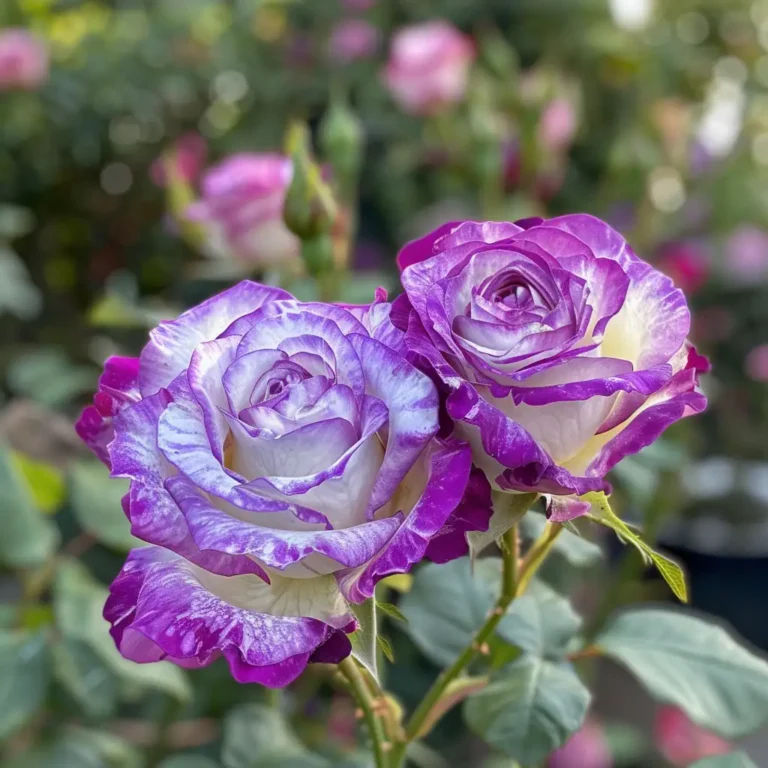Introduction
The Osiria Rose, known scientifically as Rosa ‘Osiria’, is a captivating and unique flower cherished by gardeners and rose enthusiasts alike. Its striking bi-color appearance and aromatic presence make it a standout among rose varieties.
History and Origin
The Osiria Rose has a rich history, originating from the meticulous breeding efforts of German horticulturist Reimer Kordes in the 1970s. This hybrid tea rose was developed to combine aesthetic appeal with resilience, resulting in a flower that captivates both visually and olfactorily.
Description and Characteristics
- Appearance: The Osiria Rose is renowned for its stunning bi-color petals—red on the inside and silver-white on the outside. This contrast creates a dramatic effect, making it a favorite in ornamental gardening.
- Shape and Size: The blooms are large, typically measuring 3-4 inches in diameter, and have a classic rose shape with tightly packed petals.
- Growth Pattern: This rose variety has a bushy growth habit, reaching heights of up to 3-4 feet. It blooms repeatedly throughout the growing season, offering a prolonged display of its beautiful flowers.
Growing Conditions
To cultivate Osiria Roses successfully, specific conditions must be met:
- Soil Requirements: They thrive in well-draining, fertile soil with a slightly acidic to neutral pH.
- Light and Temperature Needs: Full sun is essential for optimal growth, requiring at least 6 hours of direct sunlight daily. They prefer mild climates but can tolerate a range of temperatures.
- Watering and Fertilization: Consistent watering is crucial, keeping the soil moist but not waterlogged. Regular fertilization with a balanced rose fertilizer supports robust growth and blooming.
Planting and Care
- Planting Techniques: When planting Osiria Roses, ensure proper spacing to allow airflow and prevent disease. Dig a hole twice the size of the root ball, and mix compost into the soil to provide nutrients.
- Pruning and Deadheading: Regular pruning helps maintain the shape and encourages new growth. Deadheading spent blooms promotes continuous flowering.
- Pest and Disease Management: Common pests include aphids and spider mites, which can be controlled with insecticidal soap or neem oil. Diseases such as black spot and powdery mildew can be prevented with proper spacing and fungicidal sprays.
For comprehensive planting techniques, visit the Royal Horticultural Society.
Propagation Methods
- Propagation by Cuttings: The most common method involves taking cuttings from healthy plants, dipping them in rooting hormone, and planting them in a moist, well-draining medium.
- Other Methods: Propagation can also be done through layering or grafting, although these methods are less commonly used.
Uses and Benefits
- Ornamental Uses: The Osiria Rose is primarily used for ornamental purposes, enhancing gardens and landscapes with its striking appearance.
- Environmental Benefits: Roses, including the Osiria, contribute to biodiversity and support pollinators like bees.
- Symbolic Meanings: Roses are often associated with love and beauty, making them popular in floral arrangements and gifts.
Comparisons with Other Roses
- Differences from Other Varieties: Unlike single-colored roses, the Osiria stands out with its bi-color petals, offering a unique visual appeal.
- Advantages and Disadvantages: While its beauty is unparalleled, it requires specific care conditions that might be challenging for novice gardeners.
Popular Varieties and Hybrids
Other notable varieties related to the Osiria Rose include the Double Delight and Peace Rose. These hybrids share similar features but offer different color combinations and growth habits.
Common Problems and Solutions
- Common Diseases and Pests: Issues like black spot, powdery mildew, aphids, and spider mites are prevalent.
- Solutions and Preventive Measures: Ensuring proper spacing, adequate sunlight, and using appropriate fungicides and insecticides can mitigate these problems.
FAQs
- How to plant Osiria Rose? Plant in well-draining soil with compost, ensuring proper spacing and full sun exposure.
- What are the ideal growing conditions for Osiria Rose? Full sun, well-draining fertile soil, consistent watering, and regular fertilization.
- How to propagate Osiria Rose? Propagate by cuttings dipped in rooting hormone and planted in moist, well-draining medium.
- What are the common problems faced with Osiria Rose? Common problems include black spot, powdery mildew, aphids, and spider mites.
Conclusion
The Osiria Rose is a remarkable addition to any garden, offering unparalleled beauty and a pleasant fragrance. By understanding its growing requirements and care techniques, gardeners can enjoy the stunning blooms of this unique rose variety.

